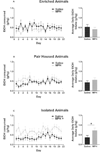Chronic methylphenidate treatment during early life is associated with greater ethanol intake in socially isolated rats
- PMID: 25156616
- PMCID: PMC4145615
- DOI: 10.1111/acer.12489
Chronic methylphenidate treatment during early life is associated with greater ethanol intake in socially isolated rats
Abstract
Background: Methylphenidate (MPH) is a stimulant prescribed to treat attention-deficit/ hyperactivity disorder. Its primary mechanism of action is in the dopamine system, alterations of which are associated with vulnerability to alcohol abuse. There are concerns that juvenile MPH treatment may influence adult drinking behavior. This study examined the interaction of MPH treatment and environmental rearing conditions, which are known to independently influence ethanol (EtOH) drinking behavior, on anxiety-like behavior and vulnerability to alcohol abuse in a juvenile rodent model.
Methods: Male Sprague-Dawley rats were housed in enriched, standard, or isolated conditions for 4 weeks, starting at postnatal day 21. Rats were concurrently treated with 8 mg/kg/d MPH or saline, delivered via osmotic minipump. Anxiety-like behavior was determined at the end of the treatment session, and 5 weeks later. After MPH treatment, rats were exposed to a 2-bottle choice EtOH drinking procedure that lasted 3 weeks.
Results: Early life chronic MPH treatment was associated with greater EtOH intake and greater EtOH preference, but only in socially isolated animals. Isolated animals had greater levels of anxiety-like behavior than standard-housed or enriched animals after 4 weeks of exposure to the housing conditions, a difference that persisted even after all animals had been individually housed for an additional 5 weeks and exposed to EtOH.
Conclusions: These results suggest that early life MPH treatment may increase vulnerability to EtOH drinking in adulthood in a subset of the population. Additionally, this study highlights the importance of early rearing condition for establishing long-lasting behavioral phenotypes. Environmental histories should be considered when prescribing MPH treatment to young children.
Keywords: Ethanol Drinking; Methylphenidate; Rearing Environment; Social Isolation.
Copyright © 2014 by the Research Society on Alcoholism.
Figures






Similar articles
-
Amphetamine, but not methylphenidate, increases ethanol intake in adolescent male, but not in female, rats.Brain Behav. 2018 Feb 19;8(4):e00939. doi: 10.1002/brb3.939. eCollection 2018 Apr. Brain Behav. 2018. PMID: 29670821 Free PMC article.
-
Adolescent rearing conditions influence the relationship between initial anxiety-like behavior and ethanol drinking in male Long Evans rats.Alcohol Clin Exp Res. 2013 Jan;37 Suppl 1(Suppl 1):E394-403. doi: 10.1111/j.1530-0277.2012.01926.x. Epub 2012 Aug 24. Alcohol Clin Exp Res. 2013. PMID: 22924742 Free PMC article.
-
The effects of rearing environment and chronic methylphenidate administration on behavior and dopamine receptors in adolescent rats.Brain Res. 2013 Aug 21;1527:67-78. doi: 10.1016/j.brainres.2013.06.021. Epub 2013 Jun 24. Brain Res. 2013. PMID: 23806775 Free PMC article.
-
Social isolation rearing increases nucleus accumbens dopamine and norepinephrine responses to acute ethanol in adulthood.Alcohol Clin Exp Res. 2014 Nov;38(11):2770-9. doi: 10.1111/acer.12555. Alcohol Clin Exp Res. 2014. PMID: 25421514 Free PMC article.
-
Ethylphenidate as a selective dopaminergic agonist and methylphenidate-ethanol transesterification biomarker.J Pharm Sci. 2014 Dec;103(12):3834-3842. doi: 10.1002/jps.24202. Epub 2014 Oct 9. J Pharm Sci. 2014. PMID: 25303048 Free PMC article. Review.
Cited by
-
Sex differences in ethanol consumption and drinking despite negative consequences following adolescent social isolation stress in male and female rats.Physiol Behav. 2023 Nov 1;271:114322. doi: 10.1016/j.physbeh.2023.114322. Epub 2023 Aug 12. Physiol Behav. 2023. PMID: 37573960 Free PMC article.
-
Attention-deficit/hyperactivity disorder in relation to addictive behaviors: a moderated-mediation analysis of personality-risk factors and sex.Front Psychiatry. 2015 Apr 20;6:47. doi: 10.3389/fpsyt.2015.00047. eCollection 2015. Front Psychiatry. 2015. PMID: 25941494 Free PMC article.
-
Sex differences, learning flexibility, and striatal dopamine D1 and D2 following adolescent drug exposure in rats.Behav Brain Res. 2016 Jul 15;308:104-14. doi: 10.1016/j.bbr.2016.04.028. Epub 2016 Apr 26. Behav Brain Res. 2016. PMID: 27091300 Free PMC article.
-
Amphetamine, but not methylphenidate, increases ethanol intake in adolescent male, but not in female, rats.Brain Behav. 2018 Feb 19;8(4):e00939. doi: 10.1002/brb3.939. eCollection 2018 Apr. Brain Behav. 2018. PMID: 29670821 Free PMC article.
-
Adolescent Social Isolation as a Model of Heightened Vulnerability to Comorbid Alcoholism and Anxiety Disorders.Alcohol Clin Exp Res. 2016 Jun;40(6):1202-14. doi: 10.1111/acer.13075. Epub 2016 May 7. Alcohol Clin Exp Res. 2016. PMID: 27154240 Free PMC article. Review.
References
-
- Bardo MT, Bowling SL, Rowlett JK, Manderscheid P, Buxton ST, Dwoskin LP. Environmental enrichment attenuates locomotor sensitization, but not in vitro dopamine release, induced by amphetamine. Pharmacol Biochem Behav. 1995;51:397–405. - PubMed
-
- Bardo MT, Klebaur JE, Valone JM, Deaton C. Environmental enrichment decreases intravenous self-administration of amphetamine in female and male rats. Psychopharmacology (Berl) 2001;155:278–284. - PubMed
-
- Biederman J. Pharmacotherapy for attention-deficit/hyperactivity disorder (ADHD) decreases the risk for substance abuse: findings from a longitudinal follow-up of youths with and without ADHD. The Journal of clinical psychiatry. 2003;64(Suppl 11):3–8. - PubMed
Publication types
MeSH terms
Substances
Grants and funding
LinkOut - more resources
Full Text Sources
Other Literature Sources
Medical

